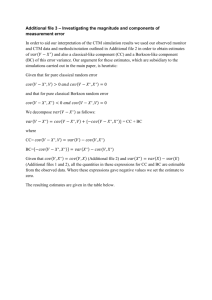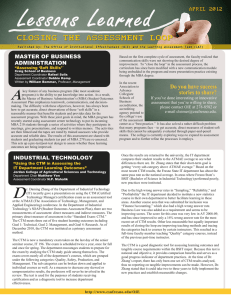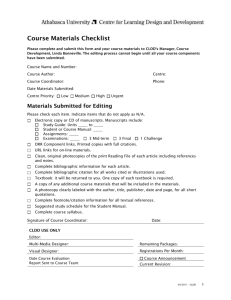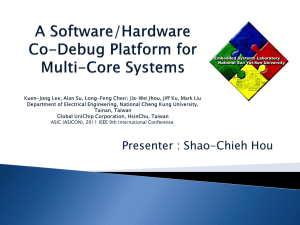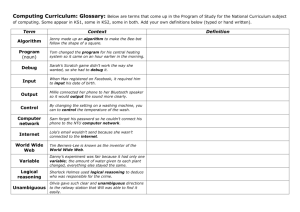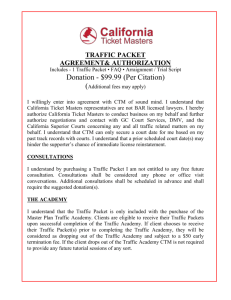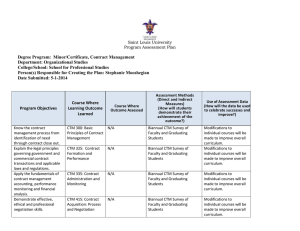4. Requirements Definition
advertisement
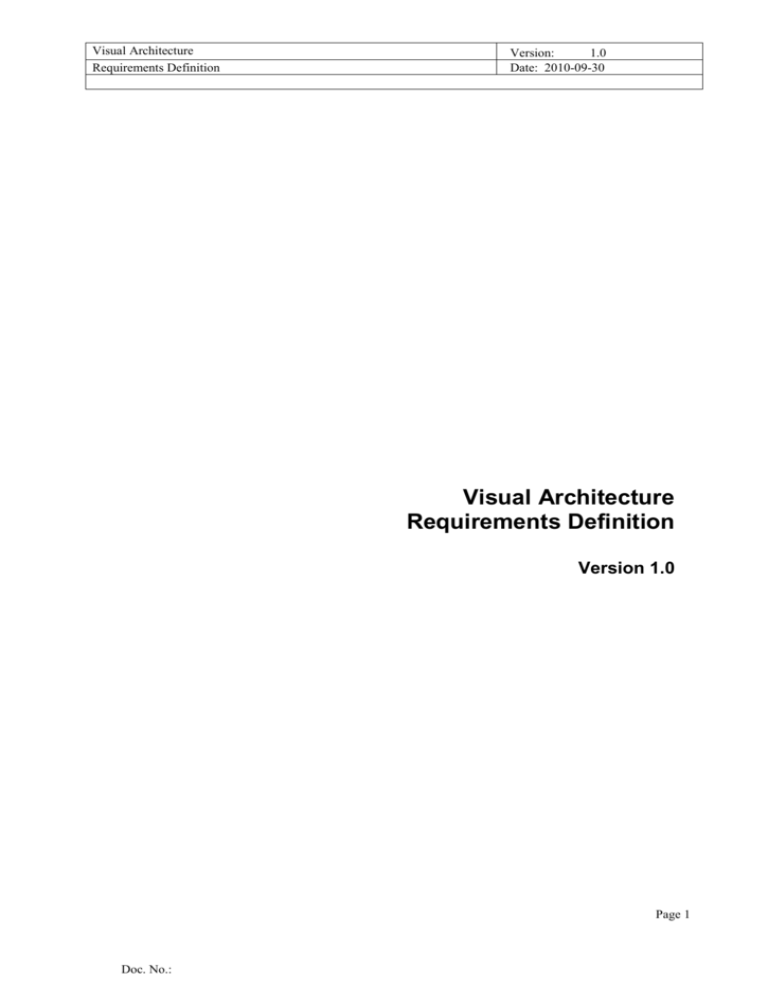
Visual Architecture Requirements Definition Version: 1.0 Date: 2010-09-30 Visual Architecture Requirements Definition Version 1.0 Page 1 Doc. No.: Visual Architecture Requirements Definition Version: 1.0 Date: 2010-09-30 Revision History Date Version Description Author 2010-09-30 0.01 Initial Draft Sarah Kuria 01.10.10 1 Final version All Page 2 Visual Architecture Requirements Definition Version: 1.0 Date: 2010-09-30 Table of Contents 1. Introduction ........................................................................................................................................................ 4 1.1 1.2 1.3 1.4 Purpose of this document ........................................................................................................................ 4 Intended Audience .................................................................................................................................. 4 Scope ....................................................................................................................................................... 4 Definitions and acronyms ....................................................................................................................... 4 1.4.1 Definitions .................................................................................................................................... 4 1.4.2 Acronyms and abbreviations ........................................................................................................ 4 1.5 References ............................................................................................................................................... 4 2. Requirements Description .................................................................................................................................. 5 2.1 2.2 2.3 2.4 Introduction ............................................................................................................................................. 5 General requirements .............................................................................................................................. 5 Specific requirements – Teacher (architecture designer) part ................................................................. 5 Specific requirements – Student part ...................................................................................................... 5 3. Use Case Models ................................................................................................................................................ 6 3.1 Use case model 1..................................................................................................................................... 6 3.1.1 Use case “Create hardware architecture”...................................................................................... 6 3.1.2 Use case “Write Assembler code” ................................................................................................ 6 3.1.3 Use case “Compile and debug Assembler code” .......................................................................... 7 4. Requirements Definition ..................................................................................................................................... 7 4.1 Requirement Group Definitions .............................................................................................................. 7 4.2 Requirement Sources .............................................................................................................................. 7 4.3 Requirements definitions ........................................................................................................................ 7 5. Future Development ........................................................................................................................................... 8 5.1 General Overview ................................................................................................................................... 8 5.2 Specific group 1 ...................................................................................................................................... 8 5.3 Specific group 2 ...................................................................................................................................... 8 Page 3 Visual Architecture Requirements Definition Version: 1.0 Date: 2010-09-30 1. Introduction 1.1 Purpose of this document The document is designed to detail the customer requirements. It seeks to define the customer needs, detail them and finally outline the planed approach to steer the project towards meeting them. It seeks to define the system boundaries and outline the anticipated possibilities of extension of the proposed solution. It seeks to envision future extension possibilities for later product versions. 1.2 Intended Audience The document contains elements that will be used by the: Project Team Steering group Customer Any other interested stakeholders 1.3 Scope The document describes the Visual Architecture project requirements. It begins by providing a general overview of the project direction then proceeds to describe various use case scenarios and give more descriptive specifications of highlighted requirements. The document concludes with a vision for the future. 1.4 Definitions and acronyms 1.4.1 Definitions Keyword Visual Architecture Drag-and-drop Code 1.4.2 Acronyms and abbreviations Acronym or abbreviation ALU 1.5 Definitions A program designed to create a visual representation of a set of computer architecture components An action where the user can move visual components to different locations on the interface using the mouse Refers to the simple assembly language supported by the Visual Architecture program Definitions Arithmetic Logic Unit – the basic component of a processor References Page 4 Visual Architecture Requirements Definition 2. Requirements Description 2.1 Introduction Version: 1.0 Date: 2010-09-30 The result of the project will be the Visual Architecture program (Eclipse plugin) that will help both teachers (architecture designers) and students understand how a program affects hardware. Teachers will design the hardware architecture on which students will work. Students will than write programs that will be compiled and run on that architecture. During runtime, students will be able to see the components interacting while performing the actions specified by their programs. 2.2 General requirements Visual Architecture program is required to enable user to do the following: Create arbitrarily hardware architecture from parts like register, ALU, memory and buses Write a program for that architecture Compile, run and debug the program created Create a graphical overview of components interaction while performing the designed program 2.3 Specific requirements – Teacher (architecture designer) part With the Visual Architecture program, teachers will be able to design hardware architecture using the drag-anddrop principle. To create the preferred architecture, they will need to add low-level hardware components already predifined; like registers, ALU’s, memory and busses that would connect to the particular hardware they have visualized. A menu list of the different types of hardware available for inclusion will be provided. Using this list and the drag-and-drop feature, the teacher will create a design. After the teacher has completed the hardware architecture design, they will be able to export the information to a file accessible to all. Teacher can also open and edit old architecture and save the changes. 2.4 Specific requirements – Student part After the student starts up the Visual Architecture program, they will need to load an existing file that contains information about some pre-designed hardware architecture. For that architecture, students will be required to write programs using simple assembler-code. Student should be able to open old code, edit code, make new code and save his code. There should also be rich text editing help like syntax highlighting and auto-complete. When program creation is complete, they will be able to compile (build) their code and utilize some debugoptions available in the system. The program would then proceed to take the students on a walk-through their code. Students will at this point experience a step-by-step graphical depiction of the happenings in their architecture when their code is run. During the debugging part the lines of code that are currently active should be highlighted as well as the proper part of architecture on which the code is running. Variables and states of registers should be shown at least on console. Page 5 Visual Architecture Requirements Definition Version: 1.0 Date: 2010-09-30 3. Use Case Models 3.1 Use case model 1 3.1.1 Use case “Create hardware architecture” Initiator: Teacher Goal: The teacher makes a hardware architecture that the students can use. Main Scenario: 1. Teacher drags some hardware-components on the main field 2. Teacher connects these with other hardware (busses) 3. (S)He saves the architecture Extensions: 3a If the teacher isn’t happy (s)he can move, delete and add more components. 3b continue at 3 3.1.2 Use case “Write Assembler code” Initiator: Student Goal: Student writes an assembler program on the given hardware. Main Scenario: 1. Student opens the given hardware architecture. 2. The student writes assembler code 3. (S)He saves the code Extensions: 2a1. If the student makes a mistake the IDE recognises it will give some suggestions a2. The student continues to 3 2b1. The student already started on his code, now he first loads his saved code. Page 6 Visual Architecture Requirements Definition 3.1.3 Version: 1.0 Date: 2010-09-30 Use case “Compile and debug Assembler code” Initiator: Student/Teacher (whoever want to see the code) Goal: Compile the code and see how the hardware deals with this Main Scenario: 1. Load hardware architecture 2. Load assembler code 3. The user presses the ‘compile’ button 4. The system compiles the code 5. The user uses ‘step-into’ and ‘step-over’ to walk through the code. System shows what is happening. 6. User closes the program. Extensions: 1a. The hardware architecture is already loaded: continue at 2 2a. The assembler code is already loaded: continue at 3 4a The code isn’t correct: The system provides info about what was wrong b. The user corrects the code and continues at 3. 4. Requirements Definition 4.1 Requirement Group Definitions Identification Requirement Group VAD Visual architecture design application/process CIE Code input and editing application/process VCR Visual code running application/process 4.2 Requirement Sources Source CTM 4.3 Description Customer(Marin Orlić from FER) Rem. Requirements definitions Identity VAD-1 VAD-1.1 VAD-1.2 VAD-1.3 VAD-2 Rem. Sta tus I I I I D Prio rity 1 1 1 1 3 Description Visual architecture design application/process Allowing teacher(architecture designer) to assemble graphical architecture Providing tools to drag and drop predetermined architecture parts Providing tools for connecting parts Providing means to open, edit and save graphical architecture Allowing teacher(architecture designer) to make new language for student and its microcode Source CTM CTM CTM CTM Page 7 Visual Architecture Requirements Definition VAD-2.1 VAD-2.2 VAD-3 VAD-3.1 VAD-3.2 VAD-4 D D H H H I 3 3 2 2 2 1 CIE-1 CIE-1.1 CIE-1.2 I I I I 1 1 1 CIE-2 CIE-3 D I 3 1 VCR-1 I I 1 VCR-1.2.1 VCR-1.2.2 I H 1 2 VCR-1.3.1 VCR-1.3.2 I H 1 2 VCR-1.4 VCR-2 VCR-3 I H I 1 2 1 CIE-1.3 VCR-1.1 1 1 Version: 1.0 Date: 2010-09-30 Providing tools for writing down language grammar Providing tools for saving or exporting grammar(language) Allowing teacher(architecture designer) to design parts Providing tools for drawing parts Providing tools for describing parts Visual architecture should be developed using Eclipse GMF and EMF Code input and editing application/process Allowing student(code runner)to enter code Providing means to make new, open, edit and save code Providing tools for code building(compiling) Providing tools for easier code editing, syntax highlighting, autocomplete. Providing means of selecting the language used Tools for code input and editing should be developed using EMF and xtext Visual code running application/process Allowing student(code runner) to debug code Providing means of selecting or importing the code for debugging Providing tools for simple(step)progressing trough lines of code Providing tools for advanced(break-point) progressing trough lines of code Showing debug information(registers, variables) trough console Showing advanced debug information (registers, variables) in special window Showing visual debug information(graphical architecture) Allowing student(code runner) to select running architecture Visual code running part should be developed using EMF and Java debugger CTM CTM CTM CTM CTM CTM CIE-1 CIE-1.1 CIE-1.2 CIE-1.3 CIE-2 CIE-3 Requirement status: I = initial (this requirement has been identified at the beginning of the project), D = dropped (this requirement has been deleted from the requirement definitions), H = on hold (decision to be implemented or dropped will be made later), A = additional (this requirement was introduced during the project course). 5. Future Development 5.1 General Overview Since Visual Architecture is quite an ambitious project, there are of course many ways in which it can be extended. 5.2 Hard-to-implement requirements (on hold or dropped) Due to the complexity of the task, several requirements have been put on hold or dropped so when one would go into further project extension, these would be the first to take into consideration. Visual architecture design application/process: Page 8 Visual Architecture Requirements Definition Version: 1.0 Date: 2010-09-30 Allowing teacher(architecture designer) to make new language for student and its microcode Providing tools for writing down the language grammar Providing tools for saving or exporting grammar(language) Allowing teacher(architecture designer) to design parts Providing tools for drawing parts Providing tools for describing parts Code input and editing application/process Providing means of selecting the language used Visual code running application/process Providing tools for advanced(break-point) progressing trough lines of code Showing advanced debug information (registers, variables) in special window Allowing student(code runner) to select running architecture 5.3 Experimental future features As with all graphical interfaces, there are many ways in which one can take the technology as an advantage to present something to the user in a more natural way – to shape the program according to the user, not vice versa. These are of course features very difficult to implement and would probably be projects on their own, but interesting none the less. For Visual Architecture, examples of such features might be: hierarchical architectures - designing and examining architectures with a hierarchical graphical representation; where a student can select the level of abstraction in which he will watch the execution of his program (for example just the processor and memory or the inside of the processor – which register is being addressed, what wire is being used) program execution animation – the student executing his program on an architecture might see data animated as if flowing from one location to another through wires; this would appear more natural to human eye and would be easier to follow changes Page 9
